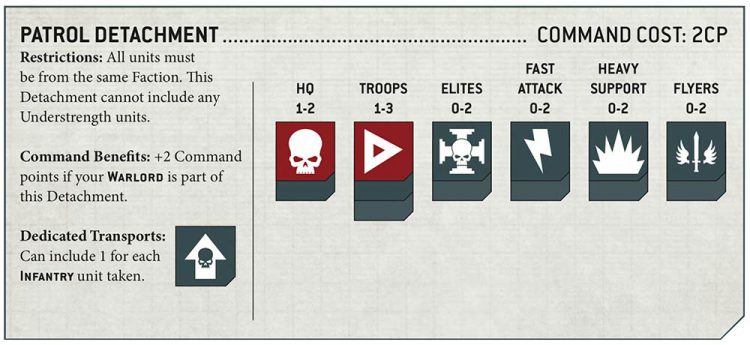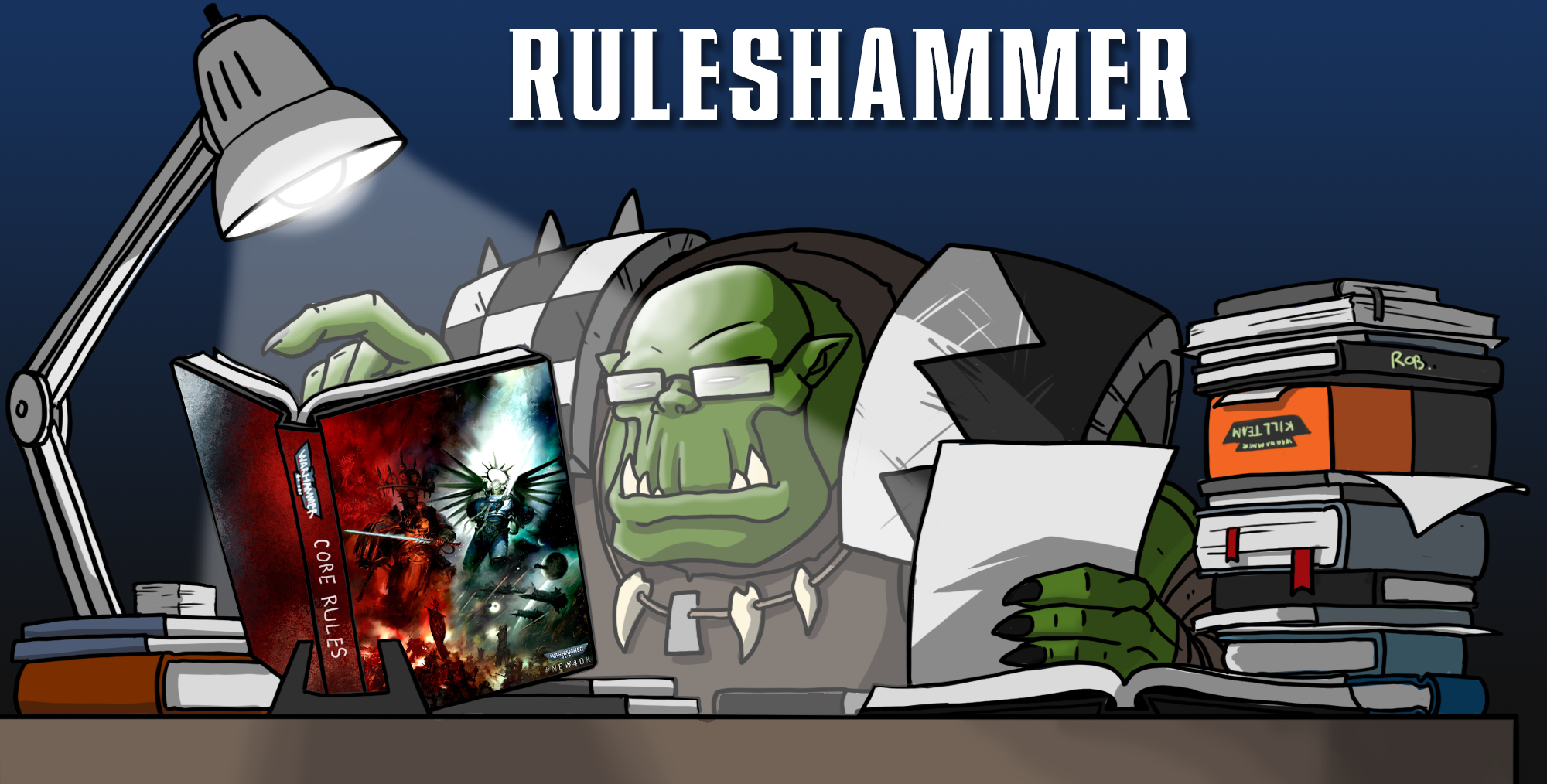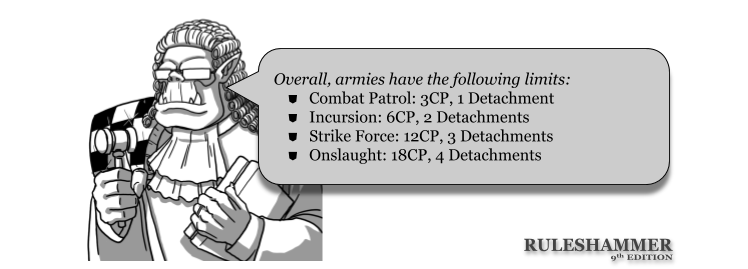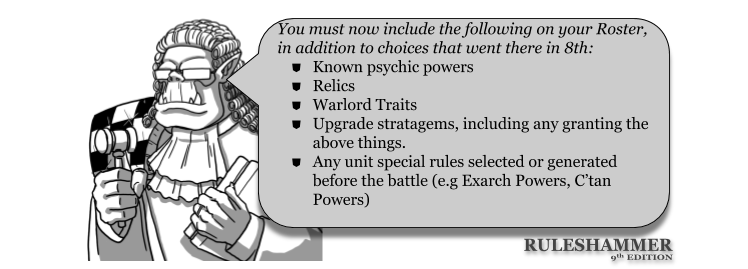With the new edition nearly upon us, we had Rob “Vre’kais” Chilton sit down with the new rulebook in the Indomitus boxed set and write his thoughts (in great detail) on the new rules – what’s changed, what needs clarification, and what you need to know. Wings is lending a hand again today as we look at Army Construction.
Army construction changes substantially in 9th Edition. The key core concept of detachments remains from 8th, but how they’re used is flipped on its head and some of them see significant changes.
Battle-Forged Armies
The concept of a Battle-Forged army, one where all the units are arranged into detachments, remains from 8th Edition pretty much unchanged. Most of the rest of the rules we talk about here concern Battle-Forged armies, and the game strongly pushes you towards making one every time.
Game Sizes
This concept is used in a few places, but it makes sense to talk about it here – 9th Edition introduces names for the common game sizes it supports. This is a great decision – it means that rather than awkwardly having to re-write the point bands each time they want to refer to a game size, they just use the names. The sizes are:
- Combat Patrol – up to 500pts
- Incursion – 501-1000pts
- Strike Force – 1001-2000pts
- Onslaught – 2001-3000pts
Adding Detachments to Your Army
CP Costs
In 8th edition successfully filling out a detachment with units and adding it to your army rewarded you with CP. By the end of the edition, the vast majority of armies aimed to fill out two Battalions at minimum to give them sweet, sweet CP to play with. This sort of made strategic sense for troop-heavy detachments, but was often quite tricky for new players to wrap their heads around as on an initial read it’s easy to wonder why you’re being rewarded for getting access to more slots, especially comnig from older editions.
9th switches this round – if you want to add a detachment to your army, you now pay a CP cost to do so, seen in the top right of their rules box.

Some detachments still give Command Benefits as well under certain conditions (as can be seen in the example) but they’re much more limited, and generally tied to your warlord.
Obviously in order to buy these you need access to some CP, which previously you would only have had three of at this point.
Starting CP
Based on the size of game you’re playing you get a different pool of starting CP to use for building your army, with any left over being your starting command point pool in your game. In Strike Force sized games (2000pts) you get 12CP to play with.
This isn’t, directly, the replacement for the old three CP base for Battle-Forging – the single CP you are given at the start of each turn is now the Battle-Forged Bonus, and this is a replacement for what you would have been able to generate by putting detachments in your army.
Detachment Limits
8th edition supplied recommended limits for the number of detachments you could use, but 9th now codifies this as a hard limit in the Battle-Forging rules. All together, you’re working within the following constraints when building your army.
Detachment Rules
Some of the detachments are pretty much unchanged from 8th other than having a cost, but some have new rules and others are gone entirely. There are also a few changes that apply more generally across all detachments.
Detachment Abilities
Abilities that units receive when every unit in a detachment shares a keyword now have a codified name – detachment abilities. This is a massively sensible change as in 8th there were a number of competing shorthand names for these in the discourse, and no single way for GW to refer to them in rules. In addition, the following detachments are codified to never receive these:
- Auxiliary Support
- Super-heavy Auxiliary
- Fortification Network
The Super-heavy Auxiliary is the main relevant change here – whether these did or didn’t before was somewhat inconsistent between codexes.
Finally, something that was previously an FAQ note is mainlined, which is that when you add units to your army mid-game with reinforcement points they are not part of a detachment, so don’t benefit from these.
Dedicated Transports
A much needed change here:
…the total number of Dedicated Transport units in a detachment can not exceed the number of INFANTRY units you have included in that detachment [Book pg247]
This shouldn’t really affect anyone who wasn’t doing something a bit wonky (looks at Wave Serpent spam lists nervously) and it’s a sensible change. It’s also worth flagging that these are no longer available as part of the Supreme Command detachment, which won’t come up at the moment thanks to other changes to it but could be fringe relevant down the line if they add any INFANTRY Supreme Commanders.
Patrols, Battalions and Brigades
All of these now refund their cost if you include your WARLORD in them. Along with other recent rules such as the new version of Imperial Agents, it’s clear that you are generally intended to build your army around a “core” of one of these.
Vanguards, Spearheads and Outriders
These do nothing special at all – they cost CP and give you slots.
Supreme Command
This is where it gets interesting. This is completely changed, and provides you with a slot to take a single HQ or Lord of War who must have either the PRIMARCH, DAEMON PRIMARCH or SUPREME COMMANDER keyword and must be your warlord. When you do this, you can refund the cost of one Patrol, one Battalion or one Brigade.
Effectively, this means the Supreme Command has exactly one function – if your faction gets a giant, named character super-leader of some sort, you can use this to take them without losing out on your free core detachment, as long as you make them your warlord. It was always pretty clear that this was what the Lord of War slot in Supreme Commands in 8th was meant to be for, but often that detachment ended up abused to bring small character contingents into other forces. You also had the weird situation of Magnus, Mortarion and Bobby G sometimes letting one of their underlings be in charge, which like, come on.
The Supreme Command now fully codifies how you take these and basically gives you a clear down-the-line choice if you want to use them without paying hefty costs – take them here, as your warlord.
Super-Heavy Detachment
This has the same slots as before, but has a varying cost. It’s 3CP if you don’t include any TITANIC units (so Armigers and a few others) and 6CP if you do. For Knights (or at least, definitely Chaos Knights, we assume both), the most prolific users of these, this is offset by a change to their Lance rules previewed on WarCom. Essentially, they can refund their first like other armies refund a core detachment.
Super-Heavy Auxiliary and Auxiliary Support
Both of these just give you a slot for points, and don’t get detachment abilities as outlined above.
Fortification Network
A good positive change here – these cost 1CP but If you take a fortification network that matches your warlord’s faction (i.e. are using only the faction-specific pieces) you get the CP refunded. With using all your detachments often no longer optimal, maybe some of these will finally see the table – the Battle Sanctum in particular seems like a good bet.
Air Wings
Are gone. They have flown off into the sunset.
Army Rosters
Hidden away in what looks like an example that you can skim, the page in the book about Army Rosters actually contains a signficant rules change, extending the list of things that you have to formally add to your army list at the point you write it.
The other change snuck in here is that if your army contains any CHARACTERS, you must select one of them to be your warlord. Most of the fringe exploit reasons to designate a random grot gunner your warlord were gone by the end of 8th, but it’s nice to ensure they basically can’t come back. Fortifications are also forbidden from being your Warlord, so in the unlikely event you manage to make a Fortress of Redemption a CHARACTER, still no dice.
Matched Play Restrictions
As a final point, something that we’ve seen cause a fair bit of confusion online is what happened to the Battle Brothers (stopping detachments using Chaos, Imperium, Aeldari, Ynnarri or Tyranids as a unifying keyword) and Rule of Three restrictions, as they aren’t in the core army building rules.
The answer is that unlike a lot of former “Matched Play” rules that have become Core, these are still only in force for Matched Play games, and are included on the first page of the Eternal War Mission Pack on page 280.
Army Construction Conclusions
Pretty much everything here is great news – Army Construction is now clearer, has fewer exploits and is arranged in a way that makes it much more accessible for new players.
Have any questions or feedback? Got a rules question you want answered? Drop us a note in the comments below, ask a question in our Ruleshammer form, or head over to r/ruleshammer to discuss.





